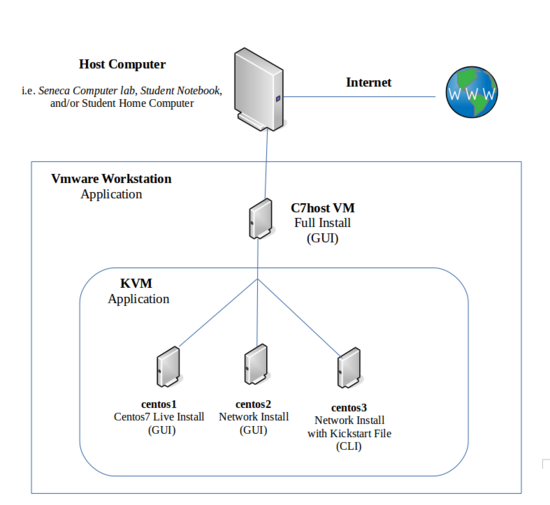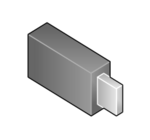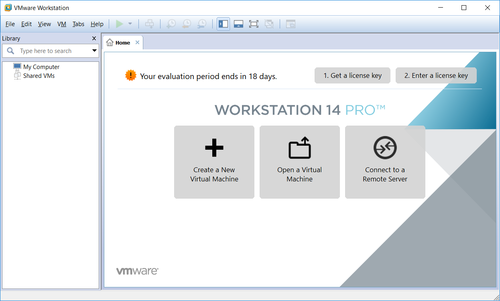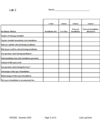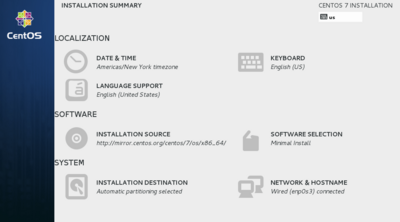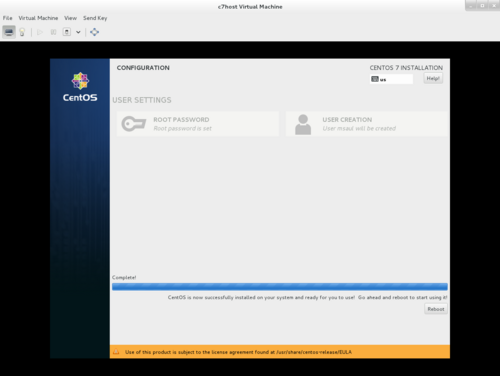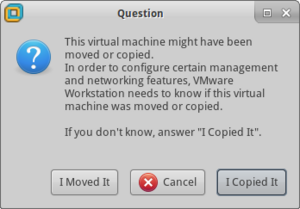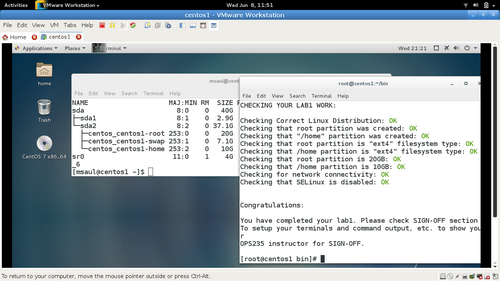Difference between revisions of "OPS235 Lab 1 - CentOS7 - VMware"
| Line 336: | Line 336: | ||
|- valign="top" | |- valign="top" | ||
| | | | ||
| − | {{Admon/note|Bash Shell Reference Guide:|<br>'''<u>She-bang Line</u>'''<ul><li>Forces shell script to run in a specific Shell</li><li>Some shell syntax not backward compatible</li><li>'''#!''' must be at beginning of first line of shell script</li><li>Example: '''#!/bin/bash'''<br><br></li></ul>'''<u>Variables</u>'''<br><blockquote>'''Environment'''<ul><li>System-wide or "global" variable</li><li>Usually appear in UPPERCASE letters</li><li>Can view with command: '''set | more'''</li><li>'''$''' in front to expand variable to value<li>Examples: '''USER''', '''PATH''', '''HOME''', '''SHELL'''<br></li></ul></blockquote><blockquote>'''User-defined''' <ul><li>Variable created by user (command line, scripting)</li><li>Examples:<br>''myVar="my value"; readonly myVar; export myVar''<br>''read -p "enter value: " myVar''<br></li></ul></blockquote><blockquote>'''Positional parameters'''<ul><li>Assign values with set command or shell script arguments</li><li>These variables are numbered (eg. $1, $2 ... $10}</li><li>Special parameters: $*, $@, $#, $$, $?<br></li></ul></blockquote>'''<u>Command Substitution</u>'''<ul><li>Useful method to expand output from a command to be used as an argument for another command.</li><li>Examples:<br>''file $(ls)''<br>''set $(ls);echo $#;echo $*''<br>''echo "hostname: $(hostname)"''<br><br></li></ul>'''<u>Logic Control Flow Statements</u>'''<ul><li>'''$?''' variable true (0) if command runs; otherwise is false (non-zero)</li>Example: | + | {{Admon/note|Bash Shell Reference Guide:|<br>'''<u>She-bang Line</u>'''<ul><li>Forces shell script to run in a specific Shell</li><li>Some shell syntax not backward compatible</li><li>'''#!''' must be at beginning of first line of shell script</li><li>Example: '''#!/bin/bash'''<br><br></li></ul>'''<u>Variables</u>'''<br><blockquote>'''Environment'''<ul><li>System-wide or "global" variable</li><li>Usually appear in UPPERCASE letters</li><li>Can view with command: '''set | more'''</li><li>'''$''' in front to expand variable to value<li>Examples: '''USER''', '''PATH''', '''HOME''', '''SHELL'''<br></li></ul></blockquote><blockquote>'''User-defined''' <ul><li>Variable created by user (command line, scripting)</li><li>Examples:<br>''myVar="my value"; readonly myVar; export myVar''<br>''read -p "enter value: " myVar''<br></li></ul></blockquote><blockquote>'''Positional parameters'''<ul><li>Assign values with set command or shell script arguments</li><li>These variables are numbered (eg. $1, $2 ... $10}</li><li>Special parameters: $*, $@, $#, $$, $?<br></li></ul></blockquote>'''<u>Command Substitution</u>'''<ul><li>Useful method to expand output from a command to be used as an argument for another command.</li><li>Examples:<br>''file $(ls)''<br>''set $(ls);echo $#;echo $*''<br>''echo "hostname: $(hostname)"''<br><br></li></ul>'''<u>Logic Control Flow Statements</u>'''<ul><li>'''$?''' variable true (0) if command runs; otherwise is false (non-zero)</li>Example:<br>''if echo $myVar | grep "match"''<br>''then''<br>''echo "Match"''<br>''fi''<br></li><li>Square brackets '''[ ]''' .Can use '''if''' / '''if-else''' / '''if-elif-else''' statements with brackets. The '''exit''' command can be used to terminate the shell script with a false value.<br><br>'''<u>Examples</u>'''<br><br>''if [ $USER = "root" ]''<br>''then''<br> ''echo "You must be root" >&2''<br> ''exit1''<br>''fi''<br><br># For number comparison: use:<br># -gt,-ge, -lt, -le, -eq, -ne<br><br>''if [ $age -gt 65 ]''<br>''then''<br> ''echo "retire"''<br>''else''<br> ''echo "don't retire"''<br>''fi''<br><br>''if [ $grade -gt 79 ]''<br>''then''<br> ''echo "You get Good Mark"''<br>''elif [ $grade -gt 49 ]''<br>''then''<br> ''echo "You pass"''<br>''else''<br> ''echo "You fail"''<br>''fi''<br></li></ul>}} |
|} | |} | ||
Revision as of 08:08, 22 May 2016
Contents
- 1 LAB PREPARATION
- 2 INVESTIGATION 1: CREATE AND INSTALL FIRST VIRTUAL MACHINE (centos1)
- 3 INVESTIGATION 2: GETTING ACQUAINTED WITH YOUR VM & CREATING SHELL SCRIPTS
- 4 LAB 1 SIGN-OFF (SHOW INSTRUCTOR)
LAB PREPARATION
Purpose / Objectives of Lab 1
You will learn how to use a popular Virtual Machine (VM) application called VMware Workstation in order to create and manage a virtual machine (Centos Linux - Full Install DVD). We will install three other Centos Linux VMs (using 3 different install methods) in lab2.
In order to save money and resources when learning to install, manage, and network various Linux machines for this course, we will be using virtualization for this course. In previous courses, students were required to purchase a removable hard disk drive to complete this course. You are NOT required (preferred) to use a removable hard-drive for this course. On the other hand, it is ESSENTIAL to have a USB key (minimum storage capacity of 16 GB) to save your Linux images in your temporary Seneca lab sessions and be able to work on your VM images on your notebook computer or desktop computer at home. You will learn during this lab how to obtain VMware Workstation 12 for your use for your notebook computer or desktop computer at home.
Main objectives:
- Use VMware Workstation 12 to create and manager Virtual Machines (VMs).
- Install the CentOS 7 FULL INSTALL DVD as a new VM.
- Get Acquainted Using the Installed Virtual Machine
- Issue commands and custom Bash shell scripts to obtain installed Linux OS information.
- Disable Linux Kernel security enhancements.
Minimum Required Materials
My Toolkit (CLI Reference)
| Package Management | System Information | Networking | Miscellaneous |
INVESTIGATION 1: CREATE AND INSTALL FIRST VIRTUAL MACHINE (centos1)
In this lab, you will learn how to install your Centos Full DVD as a virtual machine using the VMware application. Make certain to record your observations of this install in the comparison chart for centos1 in your lab2 logbook.
Part 1: Using VMware Workstation 12 to Create a New Virtual Machine (VM)
centos1 VM Details:
- Name: centos1
- Boot media / Installation: CentOS7 Full Install DVD
- Memory: 16GB
- Disk space: 40GB
- CPUs: 1
Before you can install your Centos Full Install DVD onto your Virtual Machine, you must first create a storage container which is the virtual machine that will provide a platform for you to install the Centos operating system.
Perform the Following Steps:
- Refer to this listing of installation screenshots if you need a reference:
[ installation screenshots ] - Power up the computer in your Seneca lab in Windows and insert the CentOS 7 Installation DVD into the DVD drive.
- On your Seneca computer workstation, run the VMware Workstation 12 application.
- Click on the item labelled Create a New Virtual Machine.
- Accept the Typical (default) for the Virtual Machine Configuration setting and click Next.
- Select your CD/DVD player (/dev/cdrom) as the default physical device to install operating system from and click Next.
- Make certain that the Guest Operating System is set to Linux and then click Next.
- Change the Virtual Machine Name to read centos1 and then click Next.
- Change the Disk Size to 40 GB and accept the default to Split virtual disk into multiple files and then click Next.
- Take a few moments to review the final summary screen to make certain that you make the correct configuration selections for your new virtual machine. If you notice an configuration problem, you can click the Back button to make corrections. If all is correct, then click Finish to complete the creation of your first virtual machine.
Part 2: Install Centos on your Newly-Created VM
The next step is to perform a custom installation for your Centos7 virtual machine using the Centos7 Full DVD. Upon creation of your centos1 virtual machine, The VMware Workstation application will automatically simulate a "boot" to allow you to complete the installation process to create the Centos7 operating system on that virtual machine.
Perform the following steps:
- Select from the installation menu: Install Centos7.
Note: If you experience unreadable display after you boot into your installed system, you can redo the install, but select from the install menu: Troubleshooting and then select Install in Basic Graphics Mode.# Next, you will be prompted for a language. In the first screen, select language English with subselection English-Canada and then click the Continue button on the bottom right-hand screen. - The Install Summary should now appear. This screen allows the installer to customize their Centos7 system prior to installation.
- Configure the following installation settings from the Install Summary Screen:
- DATE & TIME:
- Click on the Map to select Toronto area (you may also select from the drop-down menu section)
- Click the DONE button at the top-left corner to finish and return to the Installation Summary screen.
- NETWORK & HOSTNAME:
- Select the default Ethernet connection and click the button on the top right-hand side to change the setting from OFF to ON.
- At the bottom left-hand corner type the hostname: centos1 (all lowercase letters)
- Review your settings, then click the DONE button at the top-left corner to finish and return to the Installation Summary screen.
- SOFTWARE SELECTION:
- Select the software packages labelled: Gnome Desktop
- Click the DONE button at the top-left corner to finish and return to the Installation Summary screen.
- DATE & TIME:
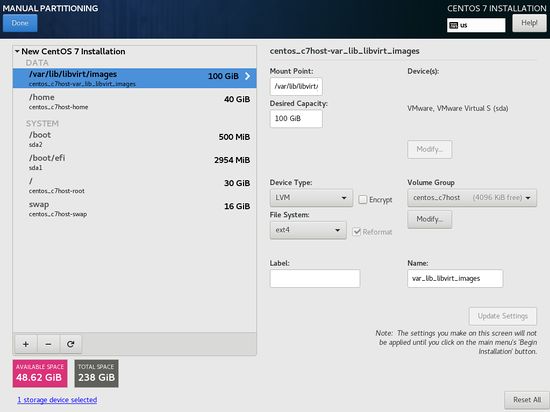 Carefully verify partition mount-names and sizes prior to proceeding with install. Check installation screenshots link for verification. |
- INSTALLATION DESTINATION:
- From the installation summary screen, click Installation Destination.
- In the installation destination screen, select the destination option: I will configure partitioning and then click Done.
- The manual partitioning screen should appear.
- If you have used your hard disk for previous Linux (Centos) distributions, you should remove them. Click on the distribution, and for each partition, select the partition and click the remove button (minus sign) and confirm deletion.
- Change the option New mount points will use the following partition scheme from LVM to Standard Partition (you will not be using LVM for your centos1 machine).
- Before you proceed with creating partitions, let's see the partitions that we need to create for our virtual machine:
- Primary Partitions (ext4):
- 20GB for / (i.e. "root")
- 10GB for /home
- Swap Partition:
- 16GB (Note: "swap" must be selected from the drop down menu)
NOTE: Remember that the sizes are recorded in MB (eg. 30 GB = 30000 MB) and you should multiply GB by a factor of 1024 to get the correct size.
(eg. 20 GB x 1024 = 20480 MB)
- Primary Partitions (ext4):
- INSTALLATION DESTINATION:
- We will now create the root (/) partition. Click on the add button (plus) sign.
- In the Add a New Mount Point screen, select / as the mount-point (either by typing or selecting from drop-down menu), and enter 20480 in for partition size and click Add Mount Point button.
- You will return to the previous dialog box.
For the / partition, change the file-system type from xfs to ext4 and make certain that the Device Type is set to Standard Partition (not LVM). You need to repeat this procedure for the /home and /var/lib/libvirt/images partitions as well). - Repeat the same steps above for the /home partition.
- Recheck each of the created partitions, and make certain that the file-system type is set to ext4 and the Device Type is set to Standard Partition.
- Finally, add a swap partition (Mount Point: swap) for 16 GB.
- Check that your partition settings are correct (you can ask your instructor or lab monitor to confirm), and then click Done (possibly twice) in order to proceed
NOTE: If there is an error message associated with your created partitions, you may need to add a /boot/efi partition (as a new mount). The capacity should be: 2954MB (i.e. 2,954 MB). Once finished, click Done. - A Summary of Changes screen will appear to show the partitioning operations that will be created. Click the Accept Changes and click Begin Installation in the Installation Summary screen to proceed with the installation.
- Start timing your centos1 virtual machine installation.
Part 3: Completing the Installation
Perform the Following Steps:
- During the installation process, you will required to create a root password (for administration access) and create a regular user account. Click on Root Password and enter your root password. Think of an appropriate password and record that password somewhere in case you forget! An indicator will appear to show you how secure your password is. Retype your root password and click Done (you may have to click Done twice if your password is not considered to be a strong password).
- You need to create a regular user account. This account will be used to graphical log into your host machine. It is never recommended to graphically log into a graphical Linux/Unix system as root. It is better to log into a regular user account, then run a command to login as root (you will learn how to do this later in this lab).
- Click User Creation and enter your full name, username, and an appropriate password (and confirm password). Click Done to finish (click twice if password is not considered to be a strong password).
- Remember to record this host installation information in the installation comparison chart in the lab2 logbook.
- When installation is complete, you will notice a message at the bottom of the screen stating: CentOS is now successfully installed and ready for you to use!
- Click the Reboot button. Your DVD will briefly open in the DVD drive bay. Make certain to remove this installation DVD so that Centos will boot from your hard drive.
- After the system reboots, a boot menu should briefly appear, then prompt the user to accept the License Information (this is only a one-time occurrence).
In order to accept the license agreement, issue the following keystrokes:
1 followed by ENTER (to select the license agreement prompt
2 followed by ENTER (to accept the license agreement)
c followed by ENTER (to save the selection)
c followed by ENTER (a second time to continue booting into the system) - The system should then graphically prompt the user to login with their regular user account. Click on your regular user account name and enter your regular user password.
- The last phase of the installation process should now run:
- Confirm English as the default input source and click Next.
- Skip the creation of online accounts by clicking Next.
- Start using your installed Linux system by clicking Start Using CentOS Linux.
- Stop timing your installation and note the amount of time that your installation took to perform. Also take the time to fill in the centos1 section of the installation comparison chart in your lab2 logbook.
- Open a web-browser and check to see if you can connect to the Internet.
Part 4: Backing up Virtual Machines to a USB Key
As mentioned above, you need to backup your VM image files for ALL of your virtual machines that you create in Seneca's computer labs via a USB key to restore and continue your virtual machine sessions in future lab sessions. You can also move a virtual machine created in a host to another host for VM Workstation. For example, you can move saved image files to your home computer to complete labs, etc. Students can download the license key for VM Workstation 12 - refer to the following link for details: [ link ]
Backing Up VM to a USB Key:
Perform the following Steps:
- Determine the location that contains your centos1 virtual machine files. Here are some common locations for various Operating Systems:
| Operating System (Platform) | Pathname |
| Windows | C:\Users\username\My Documents\My Virtual Machines\ |
| Linux | /home/userid/vmware |
| Mac OS/X |
- Create a zipped archive of the centos1 directory contained in the VM storage location (noted in step1).
- Copy the zipped archive to your USB key.
Restoring a VM from a USB Key:
- Perform the following Steps:
- To move work to your computer system running VMware Workstation, copy the archived file from your USB key to the appropriate VM storage location.
- Restore the archived file
- Launch the other VMware Workstation.
- Select File -> Open -> Browse to select the VM image in the centos1 subdirectory and a file labeled: centos1.vmx
- When starting the VM, you need to respond to the system prompt to confirm that you moved the VM to another platform.
- Proceed to Investigation 2 to obtain basic information from your newly installed centos1 virtual machine.
Answer Investigation 1 observations (all parts and questions) in your lab log book.
INVESTIGATION 2: GETTING ACQUAINTED WITH YOUR VM & CREATING SHELL SCRIPTS
For the remainder of this lab, we will be using the centos1 virtual machine that we installed in Investigation 1.
First, we will focus on using the virtual machine and become familiar with some command VM operations like switching between the full-screen and window modes. We will also learn to turn-off the screen-saver settings so you do NOT have to periodically re-issue passwords to gain access to your account (although it is a good security feature to consider in the future beyond this lab). We will also show you how to temporarily log in as the root account in order to perform tasks that are only allows for a Linux administrator.
Finally, we will continue using Shell Scripting to help automate routine tasks. For lab1, this will be creating shell scripts in order to generate information regarding the Linux system that we just installed. It would make sense that not only should a system administrator have access to hardware specifications for the computers that they support, but also information regarding the Linux operating system.
Part 1: Managing your Virtual Machine
VMware Workstation Toolbar
The VM Workstation application allows virtual machines to run in windows or full screen mode (which is toggled by pressing the key combination: ALT-CTRL-ENTER). You can press the key-combination ALT-CTRL in order to return to your host computer system (i.e. running the VM Workstation application. The VM Workstation Toolbar (displayed on right-hand side) can be accessed while in full screen mode when the mouse pointer is at the top of the virtual machine display.
Below is a table with some useful toolbar buttons and their purpose:
| Button(s) | Purpose |
| Toggle between auto-hide and always show toolbar | |
| Text-based menu for common operations | |
| Common Guest VM Operations (Left to Right):Shutdown, Suspend, Start, Restart | |
| Snapshot (i.e. Restore Points) (left to Right): Take new Snapshot, Revert to Parent Snapshot, Manage Snapshots |
|
| Exit Full Screen mode | |
| Running Virtual Machines |
Take a few minutes acquainting yourself with toggling into Full Screen mode, using the VM Workstation Tool-bar in auto-hide and always-show mode.
We will not be using the other features in this lab, but it is a good idea to make appropriate notes of these Tool-bar buttons and purposes in your lab logbook.
Turning Off Locked Screen-saver
Your system automatically enables a screen-saver application which is a useful security tool to prevent unauthorized viewing of information on a terminal after a certain amount of inactivity. Turning-off the locked screen-saver for this (and other) virtual machine can be useful when waiting for your instructor to come over to "sign-off" your computer lab without having to re-issue user passwords.
If you find this feature annoying and want to turn it off or adjust the idle time perform the following steps:
- Click on your username at the top right-hand screen
- Select Settings from the drop-down menu.
- Click the Power icon located in the Settings Dialog Box
- Change the amount of time in the Power Saving section to Never or a longer period of time
- Close the Settings Dialog box.
Part 2: Common Post-Install Tasks & Automating Routine Tasks with Shell Scripts
Accessing Administrative Priviledges
Navigate through your Graphical CentOS system, locate and run a terminal program (in order to issue Linux commands).
Issue and record the commands used and the output generated in each of the following steps:
- With older (ancient) versions of Linux, a user once may have been allowed to login to their graphical Linux system using root as their user-name and their root password. This has been determined to be a security risk and that option has been removed with many or all Linux operating systems.
- Therefore, from this point onwards, you will be logging into your regular user account instead and issuing a command to login as the root user.
- Refer to the Information box regarding how to access the admin account from the command line.
- Issue the command
suIssue the pwd and whoami commands to confirm your directory pathname. When finished logout of this account. - Issue the command
su -Issue the pwd and whoami commands to confirm your directory pathname. What do you notice are the main differences between using su versus using su - ? - An installation log file called
/var/log/anaconda/packaging.loghas been created to record the installation of your centos1 machine. This file is an ASCII file which can be viewed with themorecommand. - You can make use of this file to determine how many packages have been installed: complete the following command to count the number of packages that are labelled "Installing" in the installation log file:
-
grep -i packaging /var/log/anaconda/packaging.log | wc -l
-
Using Bash Shell Scripts
Explanation
| Button(s) | Purpose |
| Toggle between auto-hide and always show toolbar | |
| Text-based menu for common operations | |
| Common Guest VM Operations (Left to Right):Shutdown, Suspend, Start, Restart | |
| Snapshot (i.e. Restore Points) (left to Right): Take new Snapshot, Revert to Parent Snapshot, Manage Snapshots |
|
| Exit Full Screen mode | |
| Running Virtual Machines |
Perform the Following Steps:
- Issue that command displayed above. Does it work? If not, what account do you think you should be in? When you get the command working record this important information regarding commands and the admin account in your lab logbook.
- Using the
rpmcommand: you can also use the following commands to list all the installed packages, and the total number of packages installed:
rpm -q -arpm -q -a | wc -lrpm -qa | wc -l
- The
-qoption means query, and the-aoption means all (in other words, query all installed software packages). Did you get the same number of packages from the above two methods? - Some of the files on your system were installed with the software packages, and some were created by system activity (for example, by creating your Learn account and by logging in). If you know the package name (from the
packaging.log), you can list all the files that were installed from the package by using the following command:
rpm -q -l gedit
- Issue the following command to obtain the total number of files installed for gedit:
rpm -ql gedit | wc -l
- Using what you learned in steps 3, 4, and 7, get a count of the total number of files installed by all of the software packages on your system.
- How can you explain why this number is a lot larger than the total number of packages installed? Record your answer in your lab logbook.
- To find out the name that you have assigned to your Linux system, enter the command:
hostname - To find out the kernel version of your GNU/Linux workstation and the date it was created, enter the command:
uname -rv - To find out all the system processes running on your GNU/Linux workstation, enter the command:
ps -ef - We will now collect networking information for your installed system.
- To check the network configuration settings obtained from the DHCP server, run the following commands, describing the output in your log book:
-
ifconfig -
route -n nslookup(at the nslookup prompt, enter the word server and record the output. Type exit to leave nslookup).
-
- Find the following information in the output of the above commands:
-
MAC addressof the ethernet network interface Subnet mask-
The IP address(assigned to you by the DHCP server) -
The default gateway -
The DNS nameserver
-
- Run the commands
hostname,uname -rv,ps -ef,ifconfig, androute -nredirecting the output to add to a file in root's home directory calledsystem.txt. - Copy the installation log file
/var/log/anaconda/packaging.logand the file system.txt to a USB memory key, or scp to your matrix account as a backup.
You may have learned about creating and running Bash Shell Scripts in your ULI101 course. Shell scripts help Linux users and system administrators to automate repetitive tasks to become more efficient and to help them save time. You will be reviewing and building a basic Bash Shell script to generate information reports for your newly-installed Linux host machine. Take time to view Shell Scripting Tips which are located on the right-hand side.
If you require additional practice in creating shell scripts and using the vi text editor, run the commands in your Matrix account:- /home/murray.saul/vi-tutorial
- /home/murray.saul/scripting-1
Perform the following steps:
- Make certain to log out of your root account and remain as a regular user.
- Open a Shell terminal and use a text editor (such as
viornano) to create a Bash Shell script called:myreport.bashin your current directory. - Copy and paste the text below into your vi editing session for your file report.bash
(how do you copy and paste efficiently in Linux?)
#!/bin/bash
# Author: *** INSERT YOUR NAME ***
# Date: *** CURRENT DATE ***
#
# Purpose: Creates system info report
#
# USAGE: ./myreport.bash
if [ $USER != "root" ] # only runs if logged in as root
then
echo "You must be logged in as root." >&2
exit 1
fi
- Save your editing session, assign the myreport.bash file read and execute permissions (at least for the owner) and run by typing:
./myreport.bash - Did it run? If not what do you think you need to do in order to run the Bash Shell Script?
- Issue the command
su -and run the script from the regular user's home directory (not root's home directory):~regularuserid/myreport.bash - Did it work?
- Reopen your text-editing session for ~regularuserid/myreport.bash and add the following lines of code to the bottom of the shell script file:
# Create report title
echo "SYSTEM REPORT" > /root/report.txt
echo "Date: $(date +'%A %B %d, %Y (%H:%M:%p)')" >> /root/report.txt
echo >> /root/report.txt
- Save and run the bash shell script. View the contents of the file called report.txt that was generated (I hope you are using the up arrow key to issue previously issued commands in order to save time!). Notice how the redirection symbol > is used at the beginning of the report, and then the other redirection symbol >> is used to help "grow" the report with the other content.
- The only remaining content of the report would be the system information. We can use a shell scripting trick called "command substitution" $( .. ) in order place results from an command to be used by another command (like echo). Re-edit the shell script and add the following code at the bottom of the shell script file:
echo >> /root/report.txt
echo "Hostname: $(hostname)" >> /root/report.txt
echo >> /root/report.txt
echo "Kernel Version: $(uname -rv)" >> /root/report.txt
echo >> /root/report.txt
- Save, run the script, and view the report.txt contents (are you using tip that was given to save time?).
- Edit the shell script and include output from the
ps auxandifconfigcommands (with appropriate titles). Remember to redirect that output to add to the bottom of the file! - Save, run and confirm that the shell script is working correctly.
- What would be the use of keeping this shell script as a Linux system administrator?
- Here are some more "complex" Bash Shell scripts, that perform the same task. Although you are not require to understand some of these other tricks, it is recommended that you view the contents of the scripts and save them for future consideration or exmaples.
- The
wgetcommand can be used to quickly download files from the Internet. Issue the following command:wget https://scs.senecac.on.ca/~murray.saul/text-report.bash - Verify that the file text-report.bash was downloaded to your current directory.
- Assign read and execute permissions for this file by issuing the command:
chmod u+rx text-report.bash - Run this Bash Shell script by issuing the command:
./text-report.bash - Check to see if it created a report in your current directory. What is the purpose of the report?
- Use the vi text editor to view the contents of the file text-report.bash. Can you understand how this script works?
- Use the
wgetcommand to download, study, and run the following shell scripts on-line:https://scs.senecac.on.ca/~murray.saul/report.bash
https://scs.senecac.on.ca/~murray.saul/report3.bash - Try to understand what these Bash Shell scripts do.
- You have completed lab1. Proceed to Completing The Lab, and follow the instructions for "lab sign-off".
Disable SELinux and Perform Software Updates
SELinux stands for Security-Enhanced Linux. It is a component that helps to better secure the system to protect against intrusion (hackers). SELinux is enabled upon the default install of CentOS. SELinux can be a good thing, if you take care of it and know how it works. For this course it is strongly recommended that you disable SELinux by default because we won't have the time to reconfigure it every time the labs make it necessary.
Perform the following Steps:
- Disabling SELinux is quite simple, just edit the file /etc/selinux/config and set SELINUX to disabled.
- Add additional text regarding disabling SELinux.
- The CentOS software is updated frequently to add features, fix bugs, and upgrade security. Perform a system update to get the latest versions of the packages installed: Start the Firefox web browser, turn off popup window blocking (select Edit, Preferences, then select the Content tab and uncheck the box to Block Popups), then return to your web-browser, load a page, and when prompted, login to SeneNET.
- Make certain that you have at least 30 minutes available in your lab-time prior to performing a system update. Never abort a system update since it may damage your system files and render your host mahcine inoperable!
- Open a terminal and type
suto start a shell as root. Enter the commandyum updateThis will download and install all of the packages that have been updated since the installation DVD image was created. If you complete this command at Seneca it should run quite fast as Seneca College hosts a CentOS Repository mirror (a copy of all of the current CentOS packages, on a local web server).
Download and Run Lab1 Checking Script
x
Perform the Following Steps:
Answer Investigation 2 observations (all parts and questions) in your lab log book.
LAB 1 SIGN-OFF (SHOW INSTRUCTOR)
Arrange evidence (command output) for each of these items on your screen, then ask your instructor to review them and sign off on the lab's completion:
- ✓ Output of lsblk command showing correct partition names and sizes
- ✓ Contents of /etc/fstab file confirming partitions file types are ext4
- ✓ Correct IP address and MAC address
- ✓ Default route (gateway)
- ✓ DNS name server IP Address
- ✓ Contents of your report.bash shell script
- ✓ proof of yum update performed on centos1
- ✓ SELinux is disabled on centos1
- ✓ lab1 notes and first column of Comparison Chart in lab2.
Practice For Quizzes, Tests, Midterm & Final Exam
- How many packages were installed?
- How many files (correct to the nearest hundred) were installed?
- How many users were created automatically on your system (regular, admin)?
- List 2 ways that you can access your root account
- What is the difference between the commands su and su - ?
- What is the home directory for the user "root"?
- How do you determine the host name of your GNU/Linux workstation?
- What command can display the NIC's MAC address?
- What command is used to get a list of running processes on your newly-installed system?
- What is the command to copy files to your USB key?
- How can Shell Scripts be used to help automate a task performed in lab1?
